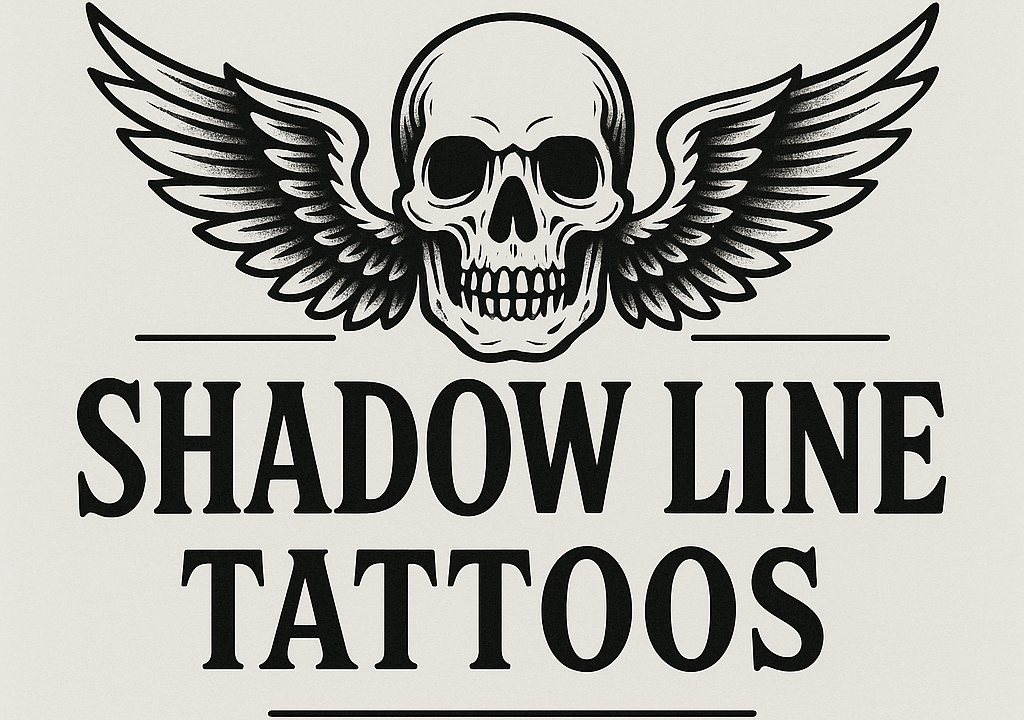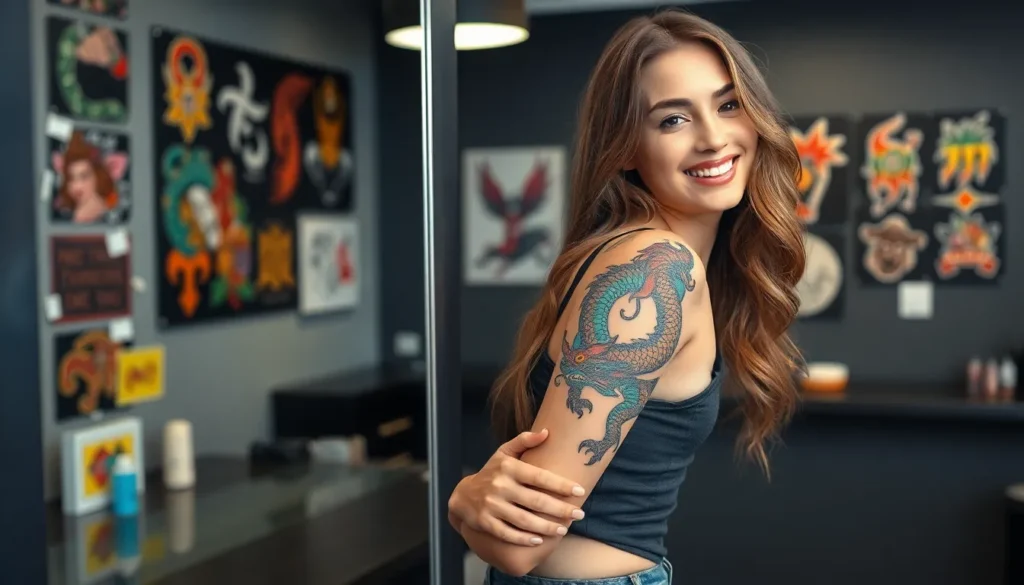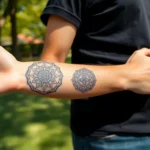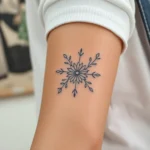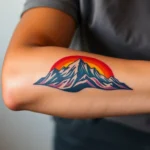Korean tattoo culture has exploded into the mainstream over the past few years and we’re absolutely fascinated by the stunning artistry emerging from this trend. From delicate minimalist designs inspired by Korean calligraphy to bold traditional motifs that honor centuries-old heritage, Korean tattoo ideas offer something truly special for ink enthusiasts worldwide.
We’ve witnessed how Korean pop culture, traditional aesthetics, and modern tattoo artistry blend together to create some of the most breathtaking body art we’ve ever seen. Whether you’re drawn to the elegant simplicity of Hangul script, the symbolic power of Korean folklore creatures, or the contemporary flair of K-pop inspired designs, these tattoos carry deep meaning while maintaining incredible visual appeal.
The beauty of Korean tattoo designs lies in their perfect balance between tradition and innovation. We’re excited to explore the most captivating Korean tattoo ideas that’ll help you express your connection to this rich culture while creating a meaningful piece of art that’s uniquely yours.
Traditional Korean Symbols and Their Meanings
Korean traditional symbols carry centuries of cultural wisdom and spiritual significance. These timeless motifs offer tattoo enthusiasts meaningful ways to connect with Korea’s rich heritage.
Yin and Yang (Taeguk) Designs
Taeguk represents the fundamental principle of balance in Korean philosophy, featuring the iconic red and blue swirling pattern found on Korea’s national flag. We see this symbol embodying the harmony between opposing forces like light and darkness, masculine and feminine energy, and creation and destruction. Korean tattoo artists often incorporate the Taeguk into larger compositions with traditional elements like clouds, waves, or geometric patterns.
Modern interpretations of Taeguk tattoos range from minimalist circular designs to elaborate sleeve pieces that blend the symbol with Korean landscapes or architectural elements. Many people choose to place these tattoos on their back, shoulder, or forearm where the circular motion can be fully appreciated. The color scheme traditionally uses deep red (representing yang) and blue (representing eum), though contemporary artists sometimes experiment with black and gray variations for a more subtle aesthetic.
Korean Dragons and Phoenix Tattoos
Korean dragons differ significantly from their Chinese counterparts, featuring four claws instead of five and representing water, wisdom, and benevolent power rather than imperial authority. We find these mythical creatures often depicted with flowing manes, serpentine bodies, and surrounded by clouds or water elements in traditional Korean art. Phoenix tattoos in Korean culture symbolize rebirth, virtue, and grace, frequently paired with peonies or cherry blossoms to enhance their feminine symbolism.
Dragon tattoos work exceptionally well as full back pieces, wrapping around the torso, or flowing down the arm from shoulder to wrist. Phoenix designs adapt beautifully to thigh pieces, ribcage tattoos, or shoulder blade placements where their wings can spread naturally. Korean tattoo artists often combine both creatures in a single composition to represent the balance between masculine dragon energy and feminine phoenix grace.
Four Gracious Plants: Plum, Orchid, Chrysanthemum, and Bamboo
The Four Gracious Plants hold special meaning in Korean culture, each representing different virtues and seasons that scholars and artists have celebrated for generations. Plum blossoms symbolize perseverance and hope, blooming even though harsh winter conditions. Orchids represent refinement and noble character, embodying elegance in simplicity.
Chrysanthemums signify longevity and integrity, particularly meaningful in Korean autumn festivals and traditional ceremonies. Bamboo represents flexibility and strength, bending without breaking under pressure while maintaining upright growth. We often see these plants tattooed individually as delicate, minimalist pieces on wrists, ankles, or behind the ear.
Combined compositions featuring all four plants create stunning sleeve tattoos or back pieces that tell a complete story of seasonal change and personal growth. Korean brush painting techniques translate beautifully into tattoo art, with flowing lines and watercolor effects that capture the organic nature of these beloved plants.
Korean Calligraphy and Hangul Script Tattoos
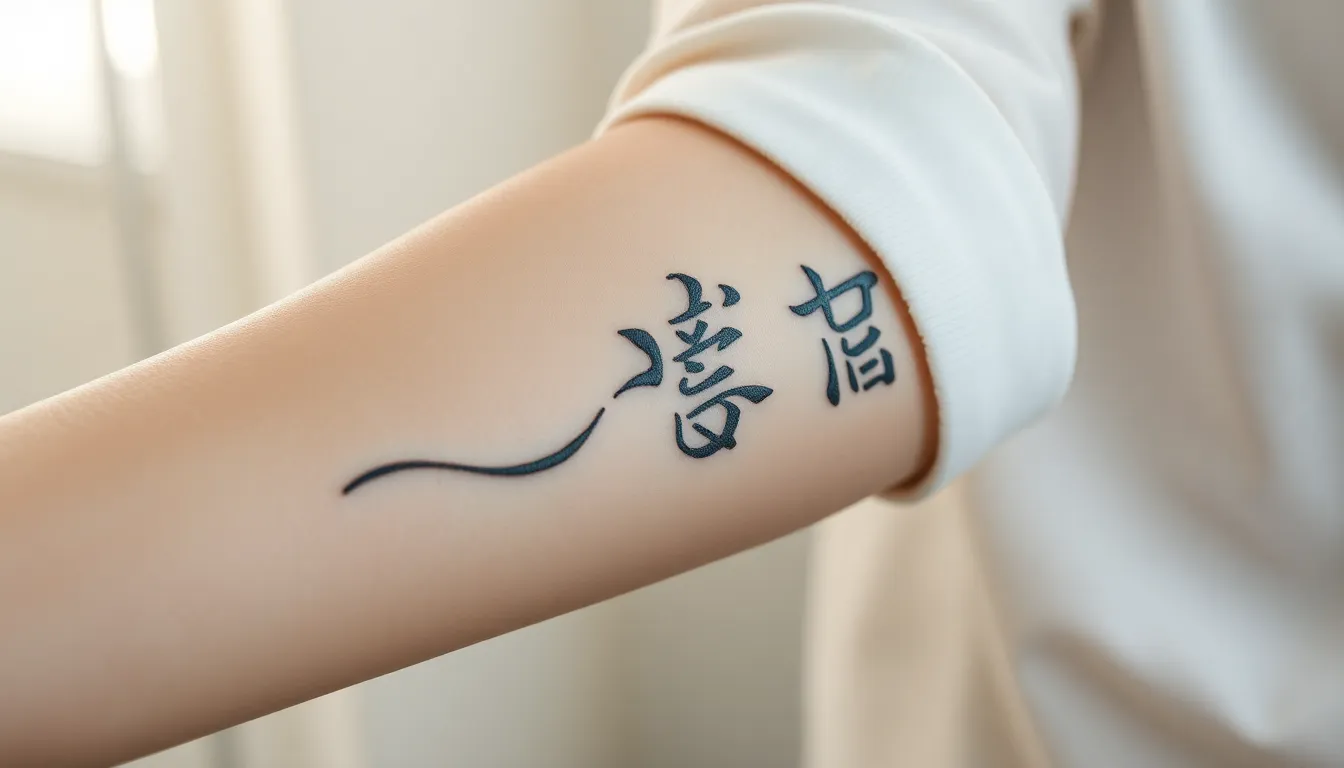
Korean calligraphy and Hangul script tattoos represent the perfect fusion of artistic beauty and linguistic heritage. These designs showcase the elegant curves and balanced structure of Korea’s unique writing system.
Meaningful Korean Phrases and Quotes
Korean phrases carry profound emotional weight when transformed into tattoo art. “Saranghae” (I love you) remains one of the most popular choices for couples seeking to express their devotion through ink. “Nae Sarang” (my love) offers another romantic option that captures deep affection in beautiful script.
Hope and faith serve as powerful motivational tattoos when written in Korean characters. These concepts translate beautifully into Hangul script and provide daily inspiration for those who wear them. Many people choose these words to represent their optimistic outlook and spiritual beliefs.
Family related phrases also hold special significance in Korean tattoo culture. Words expressing filial piety, respect for elders, and family bonds create meaningful connections to Korean values. These phrases work exceptionally well in traditional calligraphy styles that emphasize the flowing nature of Hangul characters.
Single Hangul Characters with Deep Significance
Individual Hangul characters pack remarkable symbolic power into compact designs. “Neul” represents the present moment and mindfulness, making it perfect for those who practice meditation or seek to live in the now. This character’s simple yet elegant form translates beautifully into minimalist tattoo designs.
“Saram” meaning person or human celebrates individuality and our shared humanity. This character works well for people who want to honor their identity or express universal connection. The balanced structure of this Hangul character creates visually striking tattoos that maintain readability at various sizes.
Single character tattoos offer versatility in placement and styling options. They work equally well as delicate finger tattoos or bold statement pieces on larger body areas. The geometric nature of Hangul makes these characters particularly suitable for modern tattoo techniques and artistic interpretations.
Korean Poetry and Literary Excerpts
Classical Korean poetry provides rich source material for literary tattoo enthusiasts. Excerpts from renowned poets like Kim Sowol and Yun Dong ju offer philosophical depth and cultural authenticity. These poetic lines often explore themes of nature, love, and human experience that resonate across cultures.
Traditional Korean haikus capture complex emotions in just a few carefully chosen words. Their brevity makes them ideal for tattoo applications while maintaining poetic impact. Many people select haiku verses that reflect personal experiences or life philosophies they want to carry with them permanently.
Contemporary Korean literature also inspires modern tattoo designs. Quotes from popular novels, song lyrics, and modern poetry collections provide fresh alternatives to classical texts. These selections often incorporate current language usage while maintaining the aesthetic appeal of Hangul script.
K-Pop and Korean Entertainment Inspired Tattoos
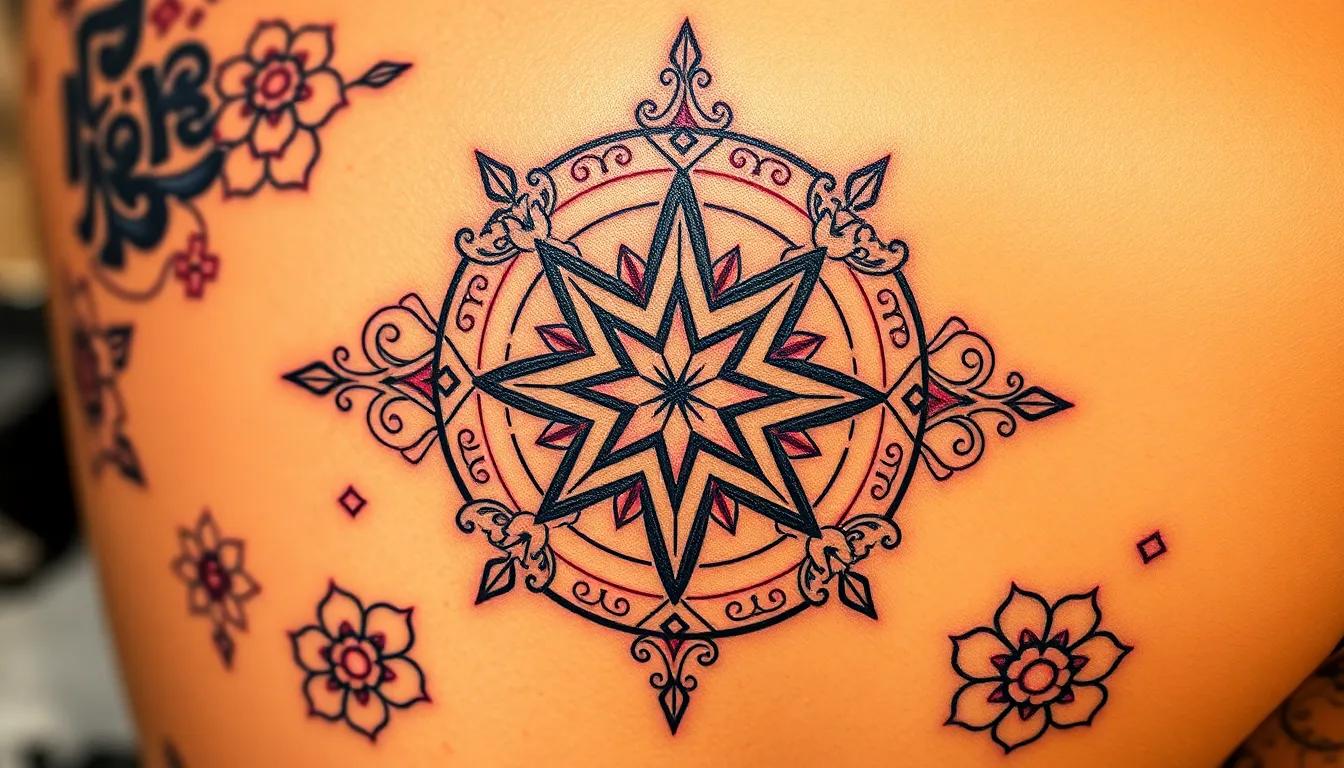
Korean entertainment has transformed tattoo culture worldwide, inspiring millions of fans to permanently ink their passion for K-pop groups, dramas, and celebrities onto their skin.
BTS and Other K-Pop Group Symbols
ARMY symbol tattoos remain among the most popular K-pop inspired designs, with fans choosing this seven-pointed emblem to represent their dedication to BTS. Many enthusiasts combine the symbol with meaningful dates like debut anniversaries or concert experiences. Blackpink’s blinking light motif offers another striking option, featuring geometric patterns that symbolize the group’s radiant energy and fan connection.
Stray Kids’ compass logo appeals to fans seeking direction and purpose in their lives, while TWICE’s candy pop symbols provide colorful, playful designs perfect for subtle placements. These group emblems serve as permanent reminders of the music and messages that shaped fans’ personal journeys.
Album artwork elements from iconic releases like BTS’s “Love Yourself” series or BLACKPINK’s “The Album” create unique tattoo opportunities. Fans often incorporate geometric shapes, floral motifs, or abstract patterns directly inspired by their favorite album covers.
Korean Drama References and Quotes
“Crash Landing on You” inspired tattoos feature romantic quotes and symbolic elements from the beloved series, with phrases like “I want to be with you until the end” resonating deeply with viewers. The show’s parachute imagery and Swiss Alpine references create meaningful visual metaphors for love conquering obstacles.
“Vagabond” tattoos often incorporate themes of justice and determination, with fans choosing powerful dialogue that reflects personal values and life philosophies. Action drama quotes about fighting for truth and protecting loved ones translate beautifully into Hangul script tattoos.
“Record of Youth” flower logos symbolize personal growth and aspirations, making them perfect for individuals marking important life transitions. These delicate floral designs combine traditional Korean aesthetics with modern entertainment culture.
Hospital Playlist musical notes and medical symbols create unique combinations for fans who connected with the show’s themes of friendship, healing, and following one’s passion even though obstacles.
Korean Celebrity-Inspired Designs
Hangul celebrity name tattoos allow fans to honor their favorite stars while showcasing the beauty of Korean script, with names like “지민” (Jimin) or “아이유” (IU) becoming popular choices. These designs often incorporate decorative elements that reflect each celebrity’s unique style or artistic persona.
IU’s moon and star motifs inspire delicate, minimalist tattoos that capture her ethereal image and musical themes about dreams and self-discovery. Her influence has popularized celestial Korean tattoo designs among international fans.
G-Dragon’s dragon imagery has significantly influenced Korean celebrity tattoo culture, with fans adapting his bold artistic vision into their own dragon-inspired pieces. His fashion-forward approach to body art encourages creative interpretations of traditional Korean symbols.
Korean actor signature styles from stars like Lee Min-ho and Park Seo-joon inspire fans to incorporate elements from their most memorable roles, creating tattoos that blend entertainment culture with personal meaning.
Korean Cultural Elements and Folklore
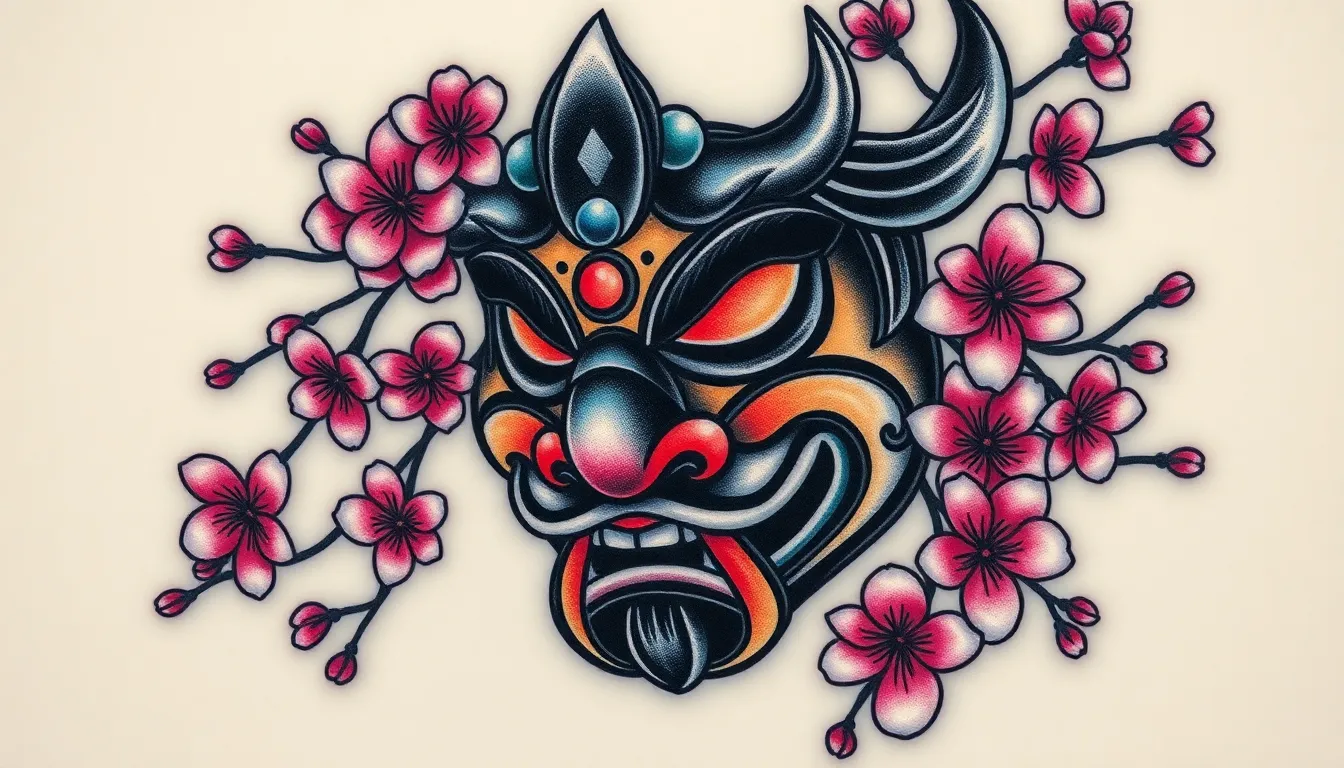
Korean tattoo artistry extends far beyond modern pop culture influences, drawing from centuries of rich folklore and traditional elements. These designs connect us to ancient stories, protective spirits, and cultural symbols that have shaped Korean identity for generations.
Hahoetal (Traditional Korean Masks)
Hahoetal masks represent the theatrical heart of Korean performance art. Traditional Korean theater and dance have used these expressive masks for centuries to convey different emotions and character archetypes. Comedy masks feature exaggerated smiles and rosy cheeks, while tragedy masks display somber expressions that capture life’s deeper struggles.
Incorporating hahoetal designs into tattoos creates powerful visual storytelling. We often see these masks tattooed in pairs to represent the duality of human experience – joy and sorrow, hope and despair. Artists typically render them in bold black linework with selective color highlights on the cheeks and decorative elements.
Norigae ornaments frequently accompany hahoetal tattoos in larger compositions. These traditional Korean decorative trinkets add feminine elegance to mask designs, creating beautiful cultural juxtapositions that honor both theatrical and ornamental traditions.
Korean Zodiac Animals
Korean zodiac animals follow the twelve-year cycle familiar to many Asian cultures. Each animal carries exact traits and protective qualities that make them meaningful tattoo choices. Tigers symbolize courage and power, making them particularly popular among those seeking strength-focused designs.
Dragons represent wisdom and good fortune in Korean zodiac traditions. Unlike their Western counterparts, Korean dragons are benevolent creatures that bring prosperity and protection. Tattoo artists often depict them with flowing manes and pearl-clutching claws, emphasizing their role as guardians rather than destroyers.
Rabbits and monkeys offer more playful zodiac tattoo options. Rabbits symbolize fertility, peace, and cleverness, while monkeys represent intelligence, curiosity, and adaptability. These animals work beautifully in minimalist line art or detailed traditional Korean painting styles.
| Zodiac Animal | Symbolic Meaning | Popular Tattoo Style |
|---|---|---|
| Tiger | Courage, Power | Bold traditional artwork |
| Dragon | Wisdom, Fortune | Flowing water elements |
| Rabbit | Peace, Fertility | Minimalist line art |
| Monkey | Intelligence, Adaptability | Playful cartoon style |
Dokkaebi and Other Mythical Creatures
Dokkaebi spirits embody mischievous magic in Korean folklore. These powerful supernatural beings are neither fully good nor evil, instead representing the unpredictable nature of magic itself. Tattoo designs often show them with their characteristic horned heads and magical clubs, symbolizing protection through cleverness and supernatural power.
Haetae creatures serve as protective guardians in Korean mythology. These lion-like beasts possess the ability to distinguish between right and wrong, making them powerful symbols for justice and moral guidance. We frequently see haetae tattoos incorporating traditional Korean architectural elements like palace rooflines or stone pedestals.
Bulgasari represents transformation and resilience in folklore. This mythical insect creature grows stronger by consuming metal, symbolizing the ability to turn challenges into strength. Modern tattoo interpretations often blend traditional Korean artistic styles with contemporary geometric patterns.
Cherry blossoms complement mythical creature tattoos beautifully. Representing life’s fleeting nature and bittersweet nostalgia, these delicate flowers add emotional depth to powerful mythological designs. Artists frequently use them to soften the intensity of creature tattoos while maintaining cultural authenticity.
Modern Korean Art and Aesthetic Tattoos
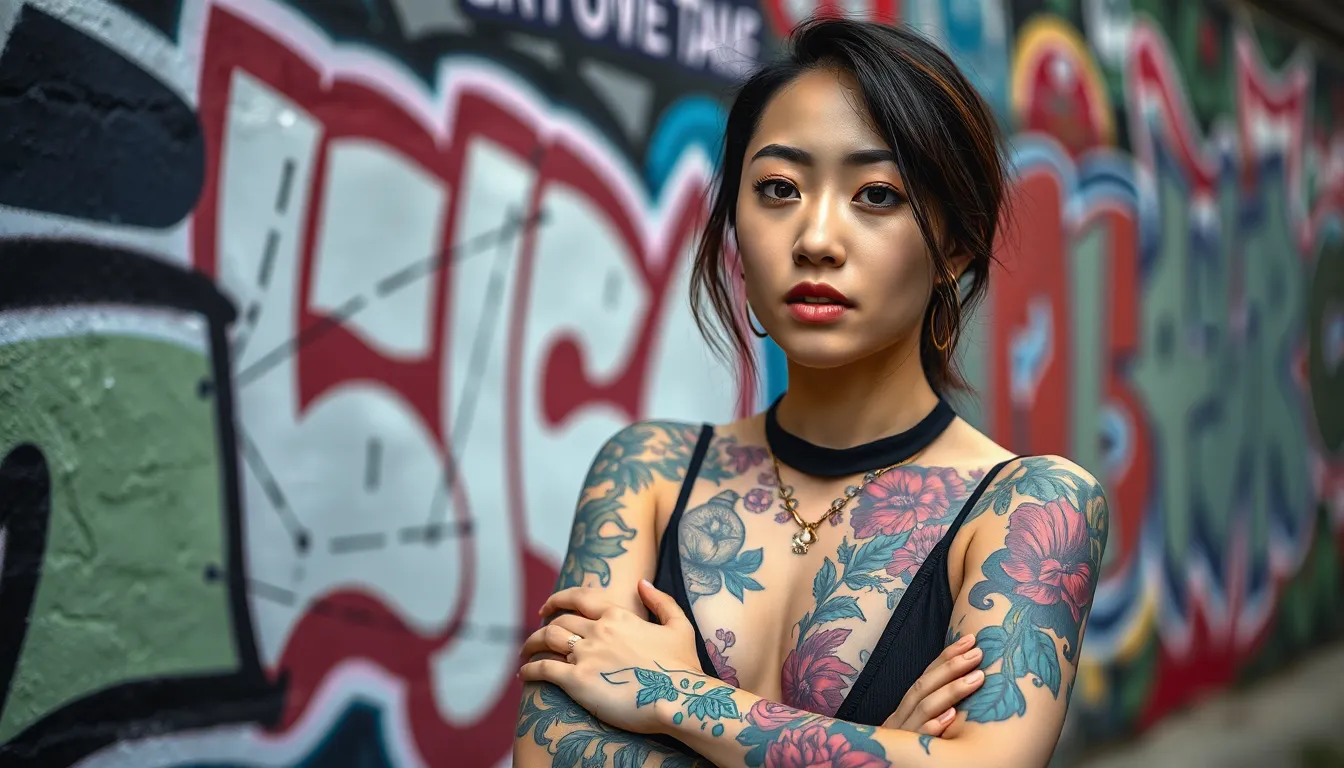
Modern Korean tattoo artistry seamlessly blends traditional cultural elements with contemporary aesthetics. These sophisticated designs have gained tremendous popularity among young people, particularly influenced by K-pop idols who’ve made tattoos a fashionable form of self-expression.
Minimalist Korean Design Elements
Clean lines define the essence of minimalist Korean tattoo designs. We see geometric shapes and simple forms creating subtle yet elegant artwork that appeals to those preferring understated aesthetics. Delicate florals, simplified Hangul characters, and mythological creatures rendered in minimal strokes showcase the beauty of restraint.
Traditional motifs like cherry blossoms or Korean tigers get reimagined through this minimalist lens. Artists reduce complex symbols to their essential elements while maintaining cultural significance. These designs often feature negative space strategically used to enhance the overall composition.
Single-line artwork has become particularly popular in modern Korean tattooing. Continuous strokes create flowing designs that can represent everything from traditional four gracious plants to contemporary abstract interpretations of Korean folklore characters.
Korean Street Art and Graffiti Styles
Vibrant colors characterize the influence of Korean street art on tattoo culture. Bold designs incorporating urban art aesthetics have emerged as artists draw inspiration from Korea’s growing street art scene. These tattoos often feature ever-changing compositions with strong color contrasts and graphic elements.
Graffiti-inspired Korean tattoos blend traditional symbols with urban typography. Artists incorporate Hangul script in graffiti-style lettering while maintaining readability and cultural respect. These designs appeal to younger generations seeking to express both their Korean heritage and contemporary urban identity.
Street art techniques like stenciling and spray paint effects translate beautifully into tattoo artistry. Artists use these methods to create layered designs that tell stories about modern Korean life while honoring traditional values.
Contemporary Korean Artist Interpretations
Watercolor techniques bring new life to classic Korean symbols in contemporary tattoo art. We see traditional creatures like phoenixes and dragons rendered with flowing colors that bleed and blend naturally across the skin. These artistic interpretations create stunning visual effects while preserving symbolic meaning.
Abstract styles allow artists to deconstruct traditional Korean motifs into modern compositions. Contemporary interpretations of hahoetal masks might feature fragmented elements or geometric reconstructions that maintain the essence while appealing to modern aesthetic sensibilities.
Mixed media approaches combine traditional Korean art techniques with modern tattoo innovations. Artists incorporate elements of Korean painting styles like minhwa folk art with contemporary shading and color theory. These fusion pieces represent the evolving nature of Korean cultural expression through body art.
Digital art influences have also shaped contemporary Korean tattoo design. Artists translate pixelated or glitch-style effects into tattoo work, creating pieces that reflect Korea’s technological advancement while maintaining cultural roots.
Korean Food and Lifestyle Tattoos
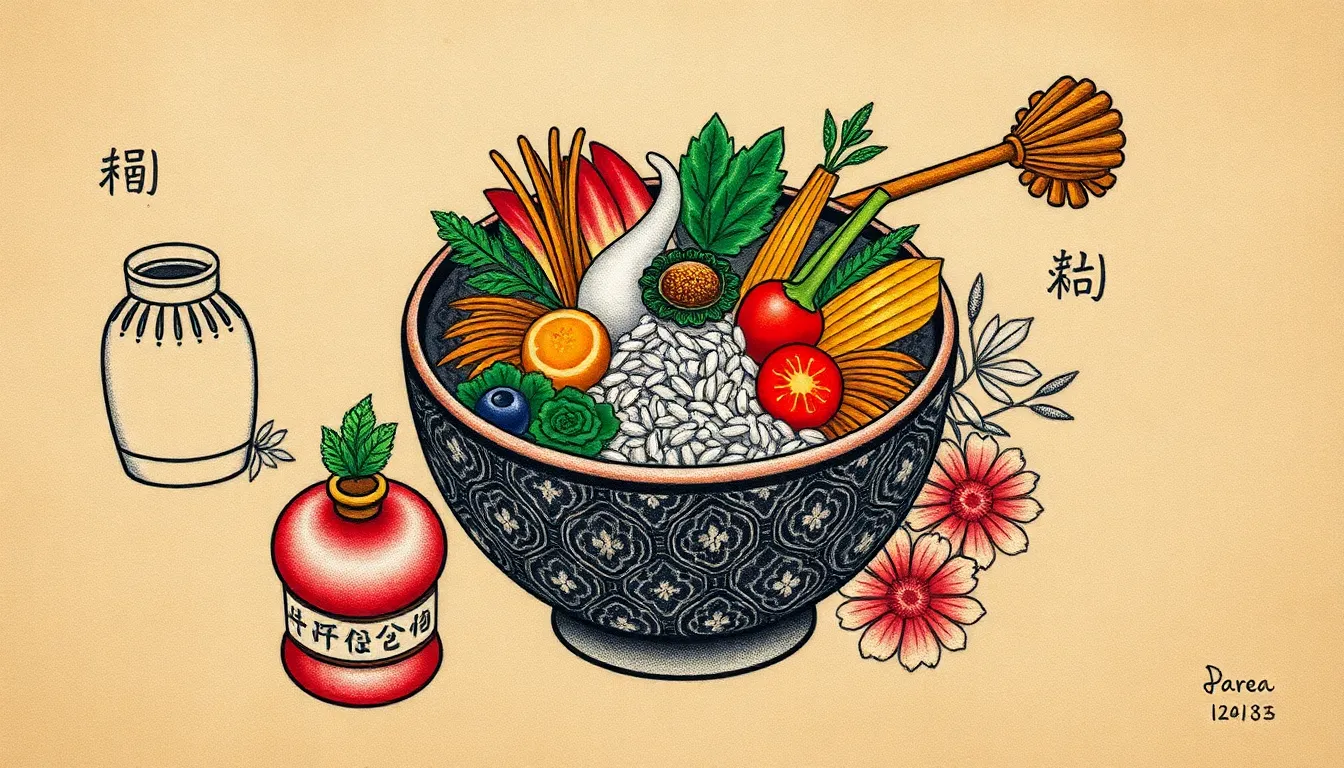
Korean culinary traditions and modern lifestyle elements offer rich inspiration for meaningful tattoo designs that celebrate both heritage and contemporary culture.
Traditional Korean Cuisine Illustrations
Traditional Korean dishes create stunning visual elements for tattoo artwork, with kimchi jars serving as popular symbols of cultural identity and fermentation traditions. Bibimbap bowls showcase the beautiful arrangement of colorful vegetables and rice, making them perfect for circular tattoo compositions that emphasize balance and harmony. Bulgogi flames and grilling scenes capture the essence of Korean barbecue culture, often paired with traditional cooking vessels like stone bowls and wooden chopsticks.
Korean chili pepper motifs (gochugaru) add vibrant red accents to food-themed tattoos, while sesame seeds create delicate dotwork patterns that complement larger culinary designs. Banchan arrangements featuring multiple small dishes demonstrate the communal aspect of Korean dining, with each element representing different flavors and family traditions.
Hanji paper textures often serve as backgrounds for these food illustrations, creating depth and connecting the designs to traditional Korean craftsmanship and artistic heritage.
Korean Tea Culture and Ceremony Elements
Tea ceremony vessels provide elegant focal points for tattoos that honor Korean mindfulness practices, with traditional teapots (dari) featuring curved spouts and wooden handles that create graceful line work. Ceramic tea cups and saucers showcase the refined aesthetics of Korean pottery, often decorated with subtle floral patterns or geometric designs that translate beautifully into tattoo art.
Green tea leaves and brewing steam create organic, flowing elements that can be incorporated into larger sleeve designs or stand alone as minimalist pieces. Bamboo tea whisks and wooden serving trays add structural elements that ground these designs in authentic ceremonial practices.
Traditional tea house architecture, including low wooden tables and floor cushions, provides contextual backgrounds that enhance the overall composition and cultural authenticity of these tattoo designs.
Modern Korean Lifestyle Symbols
K-pop inspired tattoos feature album artwork, group logos, and meaningful lyrics written in stylized Hangul script, allowing fans to permanently celebrate their connection to Korean music culture. BTS symbols, Blackpink logos, and Stray Kids emblems create instantly recognizable designs that connect wearers to global communities of music enthusiasts.
Hangul calligraphy remains the most popular choice for modern Korean tattoos, with phrases like “Fighting” (화이팅) and “Dream” (꿈) offering daily motivation through beautiful letterforms. Minimalist geometric patterns inspired by Korean architecture and modern design principles create clean, contemporary tattoos that reflect Korea’s innovative aesthetic sensibilities.
Korean skincare and beauty culture influences tattoo designs through delicate floral motifs representing popular ingredients like ginseng, green tea, and rice water, often combined with modern typography and sleek packaging-inspired elements that celebrate K-beauty’s global impact.
Korean Nature and Landscape Tattoos
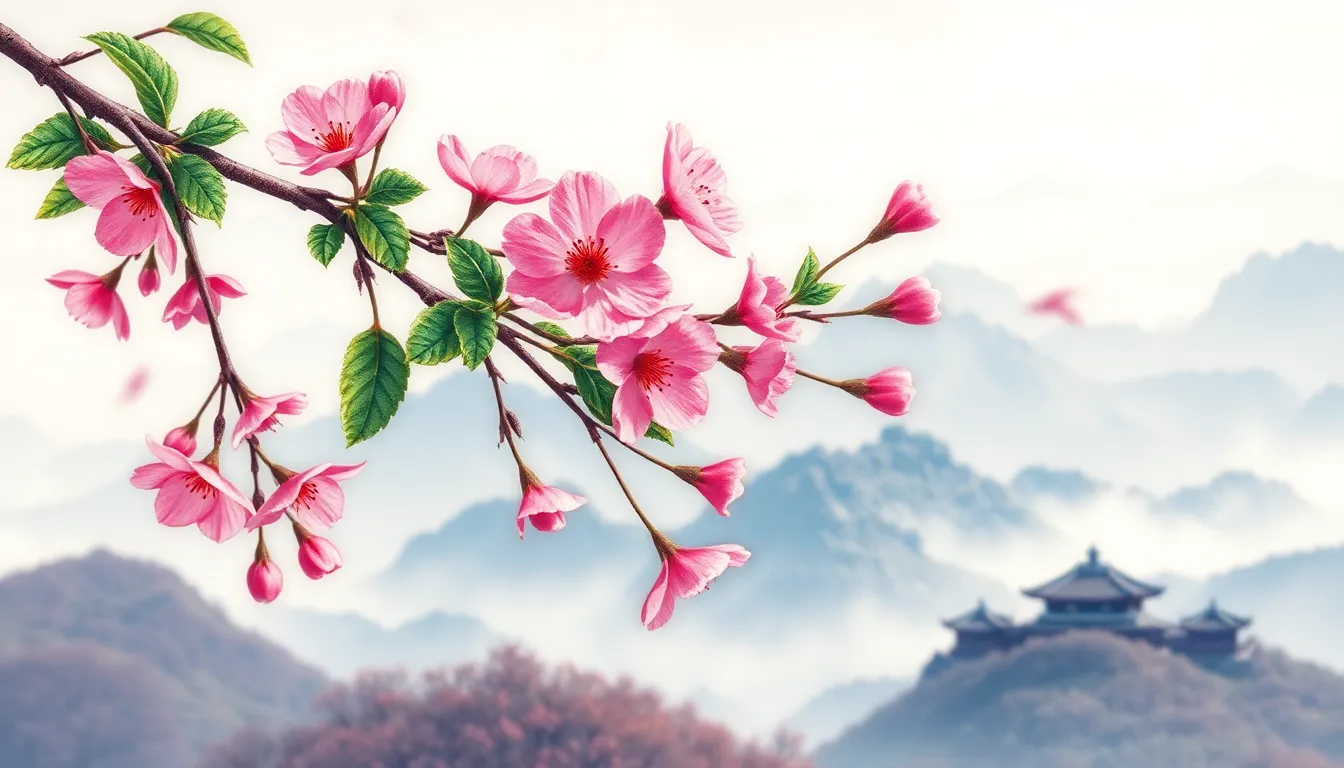
Korean nature tattoos capture the serene beauty of the peninsula’s landscapes and seasonal changes. These designs blend traditional Korean aesthetics with modern tattooing techniques to create meaningful body art.
Cherry Blossoms (Beotkkot) and Seasonal Flowers
Cherry blossoms represent the fleeting nature of beauty and life in Korean culture, making them powerful tattoo symbols. We see these delicate flowers rendered in minimalist line work that emphasizes their graceful petals and branches. Artists often incorporate subtle shading techniques to capture the translucent quality of beotkkot petals.
Peonies symbolize honor and wealth in Korean tradition, frequently appearing in vibrant watercolor tattoo styles. Chrysanthemums represent longevity and nobility, often designed with intricate details that showcase their layered petals. Lotus flowers embody purity and spiritual awakening, typically tattooed with flowing stems that wrap around arms or legs.
Seasonal flower combinations create ever-changing compositions that tell stories of Korea’s changing seasons. Spring designs might feature cherry blossoms with fresh green leaves, while autumn pieces incorporate chrysanthemums with golden accents. We recommend discussing exact flower meanings with your tattoo artist to ensure your design aligns with your personal intentions.
Korean Mountains and Traditional Architecture
Seoraksan and Taebaeksan mountains appear frequently in Korean tattoo art as symbols of strength and endurance. These iconic peaks are often depicted using traditional Korean painting techniques that emphasize misty atmospheres and layered mountain ranges. Artists capture the majestic quality of these landscapes through careful line work and strategic use of negative space.
Traditional mountain landscapes in tattoos evoke the tranquil feeling of Korean nature paintings from the Joseon dynasty. We observe how these designs incorporate elements like pine trees, rocky outcroppings, and flowing streams to create complete scenic compositions. Modern interpretations might use geometric shapes or abstract elements while maintaining the essence of Korean mountain aesthetics.
Hanok houses represent cultural heritage and connection to Korean roots in tattoo designs. These traditional structures feature distinctive curved rooflines and wooden framework that translate beautifully into tattoo art. Artists often combine hanok imagery with natural elements like bamboo or seasonal flowers.
Temple and pagoda tattoos symbolize spirituality and dedication to traditional values. Buddhist temples with their multi tiered roofs create striking vertical compositions perfect for arm or leg placements. We’ve seen these architectural elements paired with mountain backdrops to create comprehensive industry scenes.
Korean Garden Elements and Zen Designs
Bamboo symbolizes resilience and flexibility in Korean garden design, translating into elegant tattoo motifs. These plants appear in various tattoo styles from realistic depictions to minimalist line work that captures their essential form. Artists often use bamboo as framing elements around other Korean cultural symbols.
Stone arrangements represent balance and harmony with nature in traditional Korean gardens. Tattoo artists recreate these zen elements through careful placement of geometric shapes and organic forms. We notice how these designs often incorporate flowing water elements to complete the garden aesthetic.
Zen motifs in Korean tattoos include moss covered rocks, small water features, and carefully arranged plant elements. These designs emphasize negative space and minimal color palettes to create peaceful, meditative compositions. Modern interpretations might use dotwork techniques or fine line styles to achieve the subtle textures found in Korean garden elements.
Minimalist plant arrangements capture the essence of Korean garden philosophy in tattoo form. These designs focus on the relationship between different natural elements rather than detailed botanical accuracy. We recommend considering placement carefully for zen inspired tattoos, as they work best in areas where the design can flow naturally with your body’s contours.
Placement Ideas for Korean Tattoo Designs
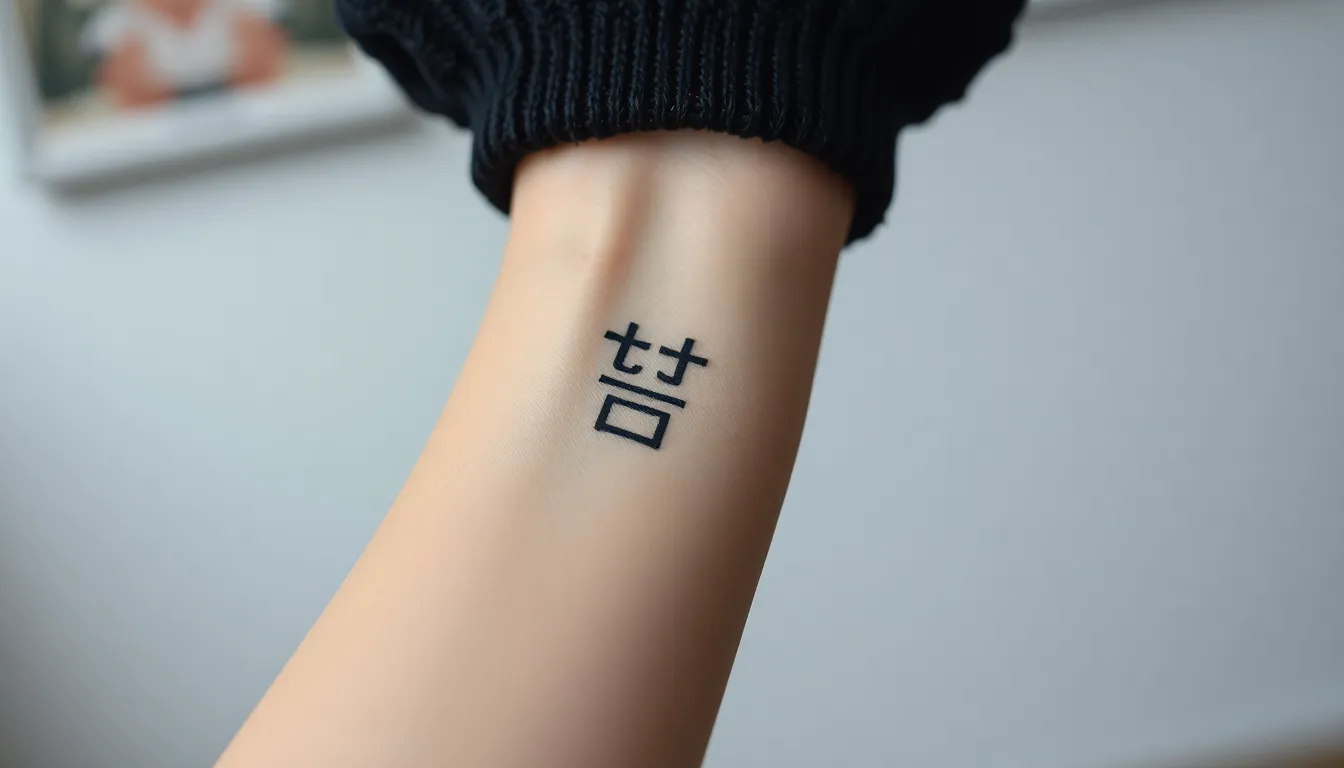
Strategic placement transforms Korean tattoo designs into meaningful expressions of cultural identity. Different body areas offer unique opportunities to showcase the intricate details and symbolic meanings of Korean artistry.
Small and Delicate Korean Symbol Placements
Wrist placements work perfectly for single Hangul characters like “힘” (strength) or “희망” (hope), creating daily reminders of personal values. Behind the ear offers an intimate location for meaningful Korean phrases, particularly romantic expressions like “내 사랑” (my love) that remain personal yet discoverable.
Ankle positioning suits traditional Korean symbols such as the Taeguk or small cherry blossom designs, allowing for easy concealment while maintaining cultural significance. Finger placements accommodate compact Hangul script tattoos, with wedding ring finger locations becoming popular for couples choosing Korean love phrases.
Inner wrist areas provide ideal canvases for Korean good luck charms or protective symbols, while the nape of the neck works beautifully for delicate hanji paper-inspired patterns. Collarbone placements showcase small Korean wave designs or minimalist representations of the Four Gracious Plants.
Large Statement Korean Art Pieces
Back canvases accommodate elaborate Korean dragon and phoenix compositions, allowing artists to incorporate traditional cloud patterns and flowing water elements across the entire surface. Chest placements work exceptionally well for Korean tigers surrounded by bamboo forests, creating powerful statements about strength and resilience.
Upper arm locations suit bold hanbok-inspired designs that wrap around the muscle, incorporating traditional Korean color palettes and geometric patterns. Thigh placements offer substantial space for Korean folklore scenes featuring dokkaebi or haetae creatures, complete with traditional industry elements.
Ribcage areas provide excellent positioning for vertical Korean calligraphy pieces, particularly poetry excerpts or meaningful phrases that flow naturally with body curves. Shoulder blade placements work perfectly for Korean mask designs, allowing the intricate details of hahoetal expressions to be fully appreciated.
Korean Sleeve and Back Piece Concepts
Full sleeve designs often begin with Korean zodiac animals at the shoulder, flowing into traditional wave patterns and cherry blossom branches that wrap around the forearm. Progressive storytelling through Korean mythology creates cohesive sleeve narratives, incorporating elements like temple architecture and mountain landscapes.
Back piece compositions typically feature central Korean dragons surrounded by seasonal elements, with spring cherry blossoms transitioning to autumn chrysanthemums across the canvas. Traditional Korean garden themes work beautifully for full back pieces, incorporating bamboo groves, stone arrangements, and peaceful water features.
Half sleeve concepts balance traditional Korean symbols with modern K-pop influenced elements, creating unique fusions that represent both heritage and contemporary culture. Geometric Korean patterns combined with Hangul script create sophisticated sleeve designs that flow from shoulder to elbow, maintaining visual harmony throughout the composition.
Color Schemes and Styling for Korean Tattoos
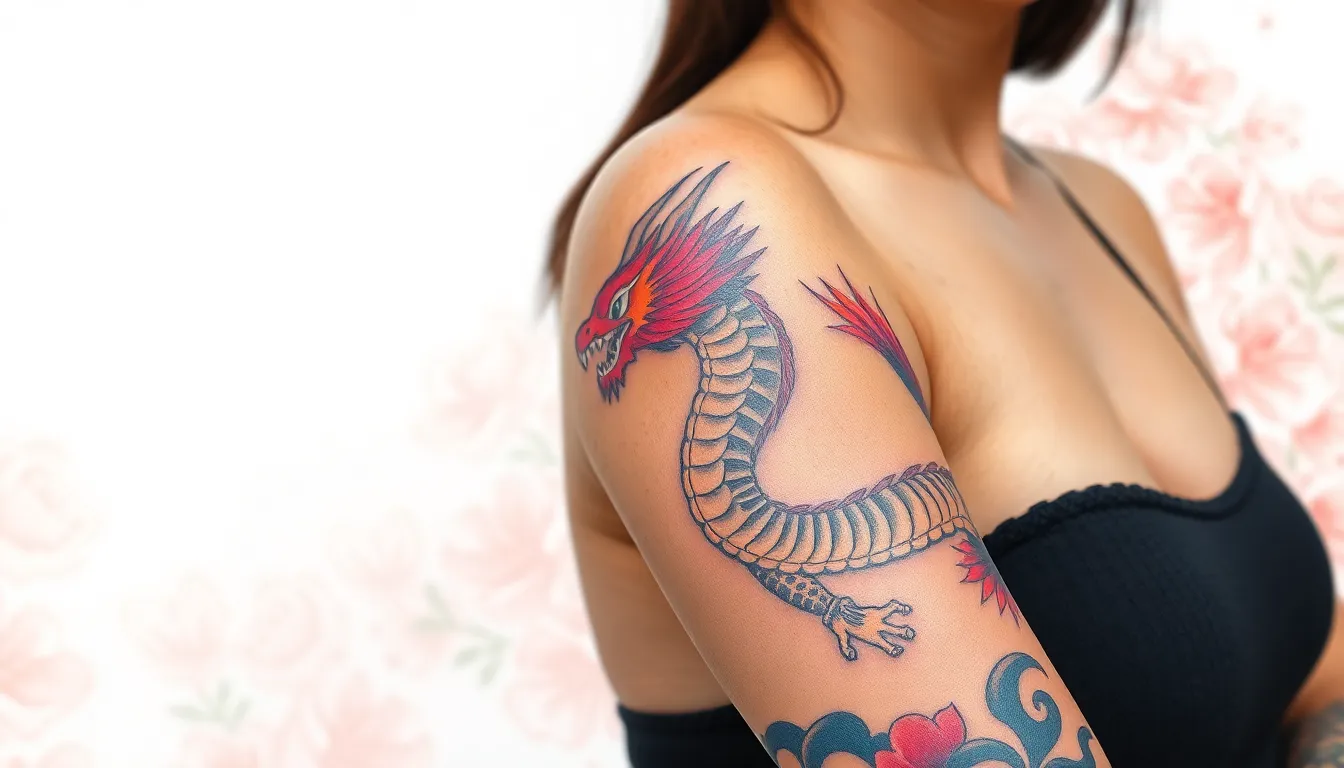
Color choices and styling techniques transform Korean tattoo designs from simple ink to powerful cultural expressions. We’ll explore how different approaches to color and style can enhance the meaning and visual impact of your Korean-inspired body art.
Traditional Korean Color Palettes
Bold and vibrant colors define traditional Korean tattoo aesthetics, drawing from centuries of cultural symbolism and artistic heritage. Red dominates many designs as it represents prosperity and good fortune in Korean culture, while blue symbolizes spiritual harmony and protection. Gold accents frequently appear in dragon and phoenix motifs, conveying themes of wisdom and divine power.
Dragons showcase the most dramatic use of traditional color schemes, with their scales rendered in deep blues and greens complemented by fiery red details. Phoenix designs burst with brilliant oranges, reds, and golden yellows that capture the mythical bird’s association with rebirth and renewal. Floral elements like peonies and chrysanthemums feature rich purples, bright pinks, and deep crimsons that reflect their symbolic meanings of honor and longevity.
| Traditional Color | Symbolic Meaning | Common Motifs |
|---|---|---|
| Red | Prosperity, good fortune | Dragons, flowers, tigers |
| Blue | Spiritual harmony, protection | Dragons, water elements |
| Gold | Wisdom, divine power | Phoenix feathers, accents |
| Green | Growth, nature | Bamboo, landscapes |
| Purple | Nobility, honor | Peonies, royal symbols |
Black and Gray Korean Minimalist Styles
Sophisticated simplicity characterizes black and gray Korean tattoo designs, emphasizing clean lines and subtle shading over bold color statements. This monochromatic approach works particularly well for Hangul script tattoos, where the elegant curves of Korean characters create stunning visual impact without additional color elements. Minimalist Korean tigers often use this palette, relying on precise linework and careful shading gradients to convey power and grace.
Geometric Korean patterns translate beautifully into black and gray work, with traditional dancheong architectural elements simplified into modern, wearable art. Subtle gray washes can create depth in mountain landscapes like Seoraksan, while maintaining the understated elegance that defines minimalist Korean aesthetics. Contemporary artists often incorporate negative space techniques, allowing skin tone to become part of the design’s overall composition.
Small Korean symbols benefit enormously from this restrained color approach, as the focus shifts entirely to form and meaning rather than visual spectacle. Hahoetal masks rendered in black and gray maintain their mysterious qualities while adapting perfectly to modern tattoo preferences for sophisticated, professional-friendly designs.
Watercolor Korean Art Techniques
Gentle color transitions and soft blending techniques create ethereal Korean tattoo designs that capture the delicate beauty of traditional Korean art forms. This contemporary approach works exceptionally well with cherry blossom designs, where pink and white hues flow seamlessly into each other, mimicking the natural beauty of Korea’s spring landscapes. Young tattoo enthusiasts particularly gravitate toward watercolor techniques inspired by Korean pop culture aesthetics.
Watercolor Korean dragons break away from traditional bold outlines, instead using flowing color washes in blues, purples, and teals to suggest the creature’s serpentine form. Artists achieve this effect by layering translucent inks that bleed naturally into surrounding skin, creating organic color gradients that feel alive and ever-changing. Floral watercolor designs often feature soft pastels that fade from deep centers to nearly transparent edges.
Mythological creatures like dokkaebi benefit from watercolor techniques that can capture their magical, otherworldly nature through color alone. Artists blend multiple hues without harsh boundaries, allowing colors to merge and separate in ways that suggest movement and transformation. This technique particularly suits Korean folklore-inspired designs, where the mysterious and supernatural elements can be enhanced through the fluid, unpredictable nature of watercolor application.
Contemporary Korean poetry excerpts rendered in watercolor Hangul create deeply personal tattoos where the words themselves seem to dissolve into artistic expression, perfectly balancing meaning with visual beauty.
Conclusion
Korean tattoo artistry offers an incredible journey through centuries of rich cultural heritage while embracing contemporary expression. We’ve explored how these designs seamlessly blend traditional symbolism with modern aesthetics creating meaningful body art that resonates deeply with wearers worldwide.
Whether you’re drawn to minimalist Hangul script delicate cherry blossoms or bold mythical creatures Korean tattoos provide endless possibilities for personal storytelling. The versatility in placement color schemes and styling techniques ensures that each piece becomes a unique reflection of your connection to Korean culture.
We encourage you to work with experienced tattoo artists who understand the cultural significance behind these designs. Take time to research the meanings behind your chosen symbols and consider how they align with your personal journey and values for a truly authentic Korean tattoo experience.
Frequently Asked Questions
What makes Korean tattoo culture unique compared to other tattoo styles?
Korean tattoo culture uniquely blends traditional aesthetics with modern K-pop influences, creating stunning artistry that balances heritage and innovation. These tattoos often feature meaningful Hangul script, traditional symbols like dragons and phoenixes, and contemporary elements inspired by Korean entertainment, offering both deep cultural significance and striking visual appeal.
What are the most popular traditional Korean symbols used in tattoos?
Popular traditional Korean symbols include the Taeguk (representing balance and harmony), Korean dragons (symbolizing wisdom), phoenixes (representing rebirth), and the Four Gracious Plants (plum, orchid, chrysanthemum, and bamboo). These symbols carry deep cultural meanings and are often incorporated into larger, meaningful tattoo compositions.
Can Hangul script tattoos be meaningful even if I don’t speak Korean?
Yes, Hangul script tattoos can be deeply meaningful regardless of language proficiency. Popular phrases like “Saranghae” (I love you), “Nae Sarang” (my love), and single characters like “Neul” (present moment) offer universal concepts of love, hope, and mindfulness that resonate across cultures while honoring Korean linguistic heritage.
How has K-pop influenced Korean tattoo designs?
K-pop has significantly transformed Korean tattoo culture worldwide, with fans getting tattoos inspired by groups like BTS, Blackpink, and Stray Kids. These designs include band symbols, meaningful lyrics, artist signatures, and imagery from music videos, allowing fans to express their dedication and personal connection to Korean entertainment culture.
What mythical creatures are commonly featured in Korean tattoos?
Common mythical creatures in Korean tattoos include dokkaebi (magical trickster spirits), haetae (protective lion-like guardians), traditional dragons, and phoenixes. These creatures embody themes of protection, magic, wisdom, and resilience, often combined with traditional elements like cherry blossoms to enhance their cultural authenticity and emotional symbolism.
What are the best placement options for Korean tattoo designs?
Placement depends on design size and personal preference. Small Hangul characters work well on wrists or behind ears, while larger traditional motifs like dragons suit backs or chests. Sleeve designs can blend traditional and modern elements, and intimate placements like ribs are perfect for meaningful Korean phrases or poetry excerpts.
What color schemes work best for Korean tattoos?
Korean tattoos utilize various color schemes: traditional palettes featuring bold red, blue, and gold for cultural symbolism; black and gray minimalist styles emphasizing clean lines; and watercolor techniques creating ethereal effects for cherry blossoms and mythological creatures. The choice depends on the design’s cultural significance and personal aesthetic preference.
Are Korean food and lifestyle elements popular in tattoo designs?
Yes, Korean culinary and lifestyle elements are increasingly popular in tattoo art. Designs featuring kimchi jars, bibimbap bowls, traditional tea ceremony vessels, and modern K-pop album artwork serve as symbols of cultural identity. These tattoos celebrate both traditional Korean heritage and contemporary lifestyle, appealing to food enthusiasts and culture lovers.
